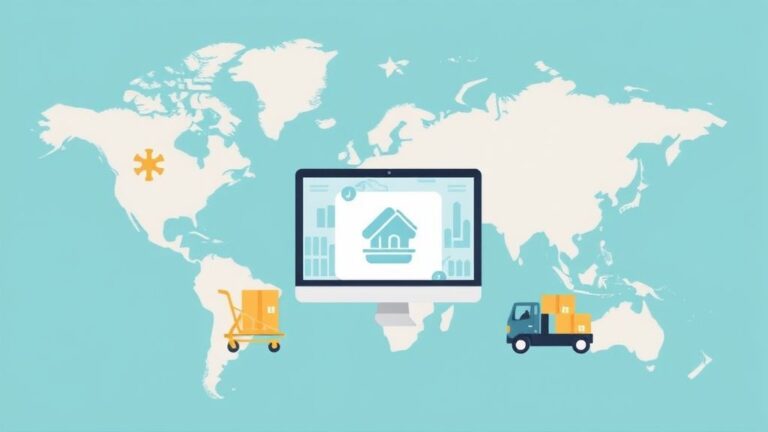How do you locate a lost package in international shipping?
International shipping has become an integral part of our daily lives in our increasingly globalized world. We order products from all corners of the globe, send gifts to loved ones abroad, and conduct cross-border business transactions.
However, we often encounter a frustrating situation – the package we eagerly await simply disappears. How can we locate a package that has gone missing in the complex process of international shipping?
This article will delve deep into this topic and provide comprehensive, practical information to help you deal with this situation.
Understanding the International Shipping Process
Before we dive into the specifics of locating lost packages, it’s crucial to understand the intricate process of international shipping.
When a package is sent from one country to another, it embarks on a long, winding journey that includes several key stages.
The shipping company initially collects the package from the sender. From there, it’s transferred to a local sorting center, where it’s processed and prepared for international shipping.
The next stage involves the package being sent to the destination country, typically via air or sea freight.
Upon arrival in the destination country, the package undergoes customs checks, which can often cause significant delays. After clearing customs, it’s sorted again at the local shipping center in the destination country and finally sent to the final address.
At each of these stages, there’s a risk that the package could go missing. Therefore, diligent tracking of the package is critical throughout the entire journey.
International Shipping Companies and Tracking Systems
Large international shipping companies invest substantial resources in developing advanced tracking systems. Companies like DHL, FedEx, UPS, and TNT offer sophisticated tracking systems that allow customers to monitor their packages in real time.
These systems provide detailed information about the package’s location, estimated delivery date, and updates on each stage of its journey. It’s important to note that many countries national postal services also offer international tracking services, although they may be less advanced than private shipping companies.
Responsibility for International Shipping Tracking
The responsibility for tracking international shipments falls on multiple parties. It’s a shared task involving various stakeholders.
The shipping company is primarily responsible for monitoring the package throughout its journey. However, both the sender and the recipient also play essential roles.
The sender is responsible for providing accurate details and tracking the package using the tracking number provided.
The recipient, in turn, is responsible for monitoring the package and reporting non-receipt by the estimated delivery date. Additionally, customs authorities play a crucial role in updating on delays or issues during customs clearance.
What Happens When a Package Goes Missing?
When a package goes missing, a complex search process begins.
The shipping company initiates a series of actions to locate the package.
This includes a thorough check of the last sorting centers where the package was scanned, examination of customs reports to ensure the package is completed on time, and checking with the previous shipping and delivery teams that handled the package.
If the package isn’t located despite these efforts, the shipping company may declare it lost. In such cases, compensation for the sender or recipient will begin according to the shipping terms and any insurance purchased.
The Process of Locating a Lost Package
When a package goes missing, acting quickly and systematically is essential. First, ensure that the package is indeed recovered and completed on time. Sometimes, shipping delays can appear as if the package has been lost.
The next step is to double-check the tracking number and ensure it’s correct. A small error in the number can lead to the wrong conclusion that the package is lost. Then, contact the shipping company. Most large companies operate customer service centers that are available around the clock and can assist in locating the package.
When contacting the shipping company, it is important to provide as much detailed information as possible. This includes the tracking number, shipping date, an accurate description of the package contents, and both the sender’s and recipient’s addresses.
Sometimes, it may also be necessary to check with customs authorities, as packages are sometimes held up in customs for various reasons.
If you’re the recipient, you should contact the sender as well. They may have additional information or be able to initiate a search process on their end.
If all attempts to locate the package fail, the final step is to file a claim with the shipping company. Ensure all required documents, including receipts and shipping confirmations, are readily available.
Types of Items and Location Methods
Different types of items require different location methods. Small, light items like letters and documents are usually checked at postal sorting centers.
More oversized items like appliances or small furniture will require physical inspection at large shipping centers.
Advanced RFID technology may secure valuable items like jewelry or small electronics. In contrast, satellite tracking systems may track huge items such as vehicles or industrial equipment.
Summary and Practical Advice
Locating a package lost in international shipping can be frustrating, but with an understanding of the process and quick, systematic action, the chances of finding the package increase significantly. It’s important to remember that most lost packages are eventually found, even if it takes time.
To avoid losing packages in the first place, it’s recommended to take a few simple steps:
- Pack the package well with clear markings.
- Ensure that address details are accurate and complete.
- Choose a reliable shipping company with a sound tracking system.
- Consider purchasing shipping insurance, especially for valuable items.
Remember, tracking technologies are constantly improving, yet there’s always some risk of losing packages in international shipping. However, with awareness, proper planning, and quick action when needed, risks can be minimized, and the chances of successfully locating lost packages can be increased.
Ultimately, international shipping is a complex process involving many factors. However, with patience, attention to detail, and prompt action in case of a problem, most packages arrive at their destination safely. And if a package goes missing, remember there are always ways to track it and eventually bring it to its destination.
International Shipping Companies Comparison
Here’s a detailed comparison of major international shipping companies:
| Company | Tracking System | Insurance Options | Customs Clearance Assistance | Average Delivery Time (International) |
| DHL | Real-time tracking with detailed updates | Multiple options available | Comprehensive assistance | 3-5 business days |
| FedEx | Advanced monitoring with predicted delivery dates | Declared value coverage | Full customs brokerage services | 1-3 business days |
| UPS | Detailed tracking with delivery notifications | Declared value and third-party insurance | Customs brokerage available | 1-5 business days |
| TNT | Online monitoring with email/SMS updates | Several insurance options | Customs clearance support | 1-6 business days |
| USPS | Basic international tracking | Global Express Guaranteed insurance | Limited customs assistance | 3-10 business days |
| Royal Mail | Tracking for select services | Compensation for loss/damage | Basic customs information | 5-7 business days |
| China Post | Tracking for EMS and registered mail | Basic insurance for registered mail | Limited customs support | 1-4 weeks |
| Japan Post | International tracking for EMS | Insurance available for purchase | Customs forms assistance | 2-6 business days (EMS) |
| Deutsche Post | Tracking for premium services | Insurance options available | Customs declaration support | 4-10 business days |
| Australia Post | Tracking for Express and Standard | Extra cover available | Online customs information | 2-10 business days |
This table provides a comprehensive overview of the services offered by major international shipping companies.
It’s important to note that delivery times and services may vary depending on the specific origin and destination countries and the chosen shipping method.
When choosing a shipping company, consider factors such as the urgency of your shipment, the value of the items being shipped, and the level of tracking and insurance you require. For high-value or time-sensitive shipments, companies like DHL, FedEx, and UPS often provide the most reliable and fastest services, albeit at a higher cost. National postal services like USPS, Royal Mail, or China Post may offer more economical options for less urgent or lower-value shipments.
The tracking systems of private courier companies like DHL, FedEx, and UPS are generally more advanced and provide more detailed, real-time information than those of national postal services. This can be particularly important when shipping valuable items or when timely delivery is crucial.
Insurance options also vary widely between companies. While most offer primary coverage, the extent of this coverage and the ease of making claims can differ significantly. For high-value items, it’s often worth considering additional insurance coverage.
Customs clearance assistance is another important factor, especially for businesses engaged in frequent international shipping. Companies like DHL and FedEx offer comprehensive customs brokerage services, which can significantly smooth the process of international shipping and reduce the likelihood of delays or lost packages due to customs issues.
Delivery times can vary greatly depending on the service chosen and the destination. Express services from major courier companies can deliver internationally in as little as 1-3 business days, while economy options or shipments through national postal services may take several weeks.
When dealing with lost packages, the robustness of a company’s tracking system and customer service responsiveness can make a significant difference. Companies with more advanced tracking systems can often provide more detailed information about a package’s last known location, which can be crucial in locating lost items.
It’s also worth noting that while this table provides a general overview, shipping companies often have multiple service tiers with different features and pricing. For example, FedEx offers services ranging from the ultra-fast FedEx International First to the more economical FedEx International Economy.
Lastly, no shipping company is immune to occasional losses or delays. Even with the most reliable courier, it’s always wise to properly insure valuable shipments and to keep detailed records of what you’ve shipped, including photographs and detailed descriptions of the items. This information can be invaluable if you must file a lost package claim.
By understanding the strengths and limitations of different shipping companies, you can make an informed choice that balances cost, speed, reliability, and the level of service you need. This knowledge, combined with proper packaging and documentation, can significantly reduce the risk of losing packages in international shipping and improve your chances of successfully resolving any issues that do arise.



